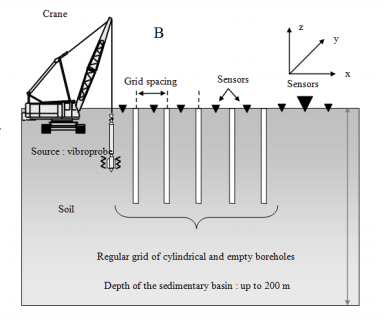First Test of Seismic Invisibility Cloak
The ability to steer electromagnetic waves around regions of space has revolutionised optics and sparked a global interest in Harry Potter-style invisibility cloaks. But it isn’t only photons that are the target of these devices.
Various engineers and physicists have also begun work on acoustic versions that steer sound. In particular, a few groups have begun to think about how this technology might be used to steer seismic waves round buildings. The idea would be to protect high value buildings such as nuclear power stations or airports. We examined just such a proposal last year.
So far, all these ideas have been numerical studies. Today, a group from the Institut Fresnel in Marseille and the ground improvement specialist company, Menard, both in France, say they’ve built and tested a seismic invisibility cloak in an alluvial basin in southern France. That’s the first time such a device has been constructed.
This story is only available to subscribers.
Don’t settle for half the story.
Get paywall-free access to technology news for the here and now.
Subscribe now
Already a subscriber?
Sign in
You’ve read all your free stories.
MIT Technology Review provides an
intelligent and independent filter for the
flood of information about technology.
Subscribe now
Already a subscriber?
Sign in
The secret of invisibility cloaks lies in engineering a material on a scale smaller than the wavelength of the waves it needs to manipulate. The appropriate sub-wavelength structures can then be arranged in a way that steers waves.
The French team created its so-called metamaterial by drilling three lines of empty boreholes 5 metres deep in a basin of silted clay up to 200 metres deep. They then monitored the area with acoustic sensors.
The experiment consisted of creating waves with a frequency of 50 Hertz and a horizontal displacement of 14 mm from a source on one side of the array. They then measured the way the waves propagated across it.
The French team say its metamaterial strongly reflected the seismic waves, which barely penetrated beyond the second line of boreholes.
The metamaterial is designed to work at the specific wavelength used in the test andseismic waves cannot be guaranteed to have this same wavelength. But by matching the array to the resonant frequency of a building, the thinking is that it could still provide some protection.
There are important caveats, however. One problem with this kind of array is that the reflected waves could end up doing more damage to buildings nearby. That’s why some groups are looking at metamaterials that absorb energy rather than steer or reflect it.
Nevertheless, there are bound to be installations that could benefit from this kind of protection. And since creating these arrays looks relatively simple, it looks to be only a matter of time before we will see them in action for real.
Ref: arxiv.org/abs/1301.7642: Seismic Metamaterial: How to Shake Friends and Influence Waves?
